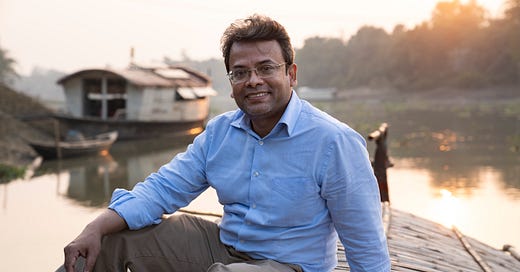FLOATING SCHOOLS NAVIGATE BANGLADESH’S LAND OF WATER
But How Soon Will the Rest of the World be in the Same Boat?
Why subscribe to HOT GLOBE? We have curiosity. All things climate change, oceans, biodiversity and politics fascinate us. We’re pissed at those burning up your future, but we get some laughs skewering the bastards, too. And we are thoughtful about the transition. If you can upgrade to paid, that covers the costs for those around the world who cannot. So, thanks, if you can:
(All photos credit Abir Abdullah/ Shidhulai Swanirvar Sangstha)
INNOVATIVE ARCHITECT MOHAMMED REZWAN created floating schools on boats to educate tens of thousands of children during the increasing floods and monsoons in Bangladesh. Could they serve as a model for a drowning world in the future, when New Orleans, Miami, and parts of New York are gone?
Bangladesh is a country of 168 million people. Its delta coastline ia only 3-4 feet above a rising sea. Every year 20% of the country is under water with at least 700,000 people displaced. The situation will become dire, according to the Intergovernmental Panel on Climate Change (IPCC)
by 2050, when 16% of Bangladesh will be submerged with 20 million climate refugees. (Yes, 20 million.) Other predictions say the situation will become much worse much quicker.
Two decades ago Muhammed Rezwan saw this coming. Already tens of thousands, sometimes hundreds of thousands of children couldn’t get to school as annual monsoons flooded out major rivers. By and large these were poor kids. Half the population still has no ownership of land, and girls, then, were kept at home.
Rezwan’s parents did have a boat, and this gave him the initial idea. But only one child showed up the first day for the first floating school, called Shidhulai Swanirvar Sangstha which roughly means “self-reliant village.” Six more came over the week, then word got out. The boats motored to homes like school buses, picked up children and when full, set anchor and the teaching began. Hundreds of Rezwan’s floating schools, and welcome copycats, ply the floodwaters of Bangladesh now with internet, desks and solar cells on the roof to power lights for night school.
The boats are locally made and staffed. They incorporate floating gardens, fish pens, and enclosures for ducks. Other boats work as floating health centers and floating employment training for traditional agriculture methods.
The floating schools have spread to the Philippines, India and Africa.
It’s a positive story of compassion and mitigation and perhaps a warning for the future.
How soon will they be floating down Canal and Water Streets in Manhattan, the still-above ground Garden District of New Orleans, and the porous sunken horizontal skyscrapers of Miami after a later Category 6 hurricane?
We smile in science fiction:
TO LISTEN TO THE AUDIO OF HOT GLOBE’S INTERVIEW WITH MOHAMMED REZWAN, PLEASE UPGRADE HERE:
DONATIONS TO MOHAMMED REZWAN’S FLOATING SCHOOLS MAY BE MADE THROUGH THE NGO NON-PROFIT ORGANIZATION BY CLICKING
HERE.
https://shidhulai.org/









